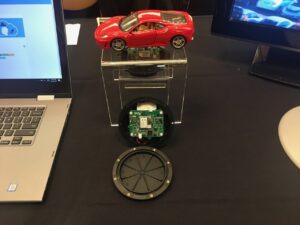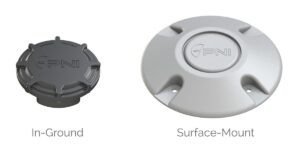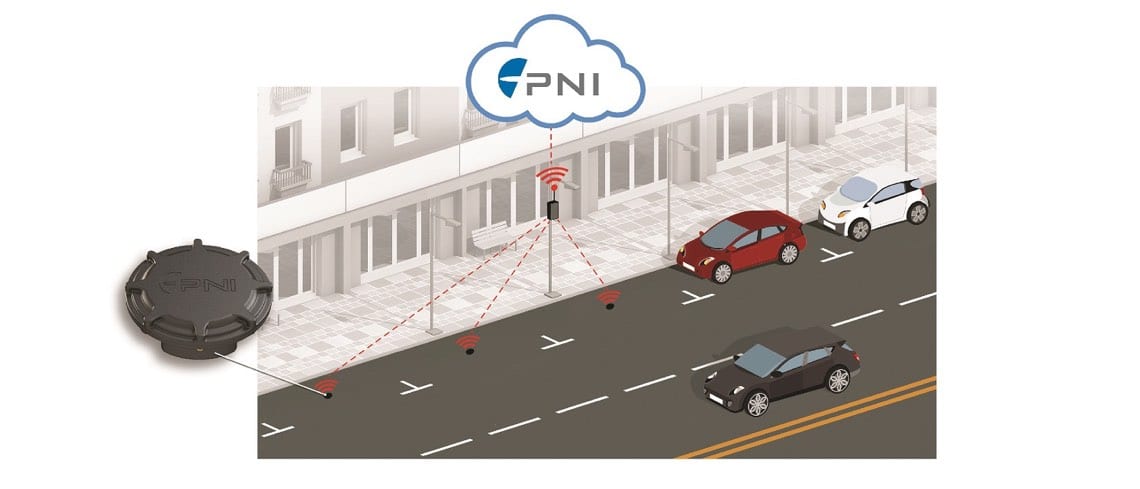PlacePod is a smart parking sensor by PNI Sensor that uses an STM32L0 microcontroller (MCU) to help improve battery life. The device is small enough to fit in one hand but still manages to be precise, reliable, and fast. Placed at a parking spot (under or above ground), it detects when a car is parked and immediately sends a signal to a cloud system using a sub-gigahertz network such as LoRa or Sigfox.
Companies can then create applications to guide their users and take advantage of this information, which reduces the time drivers need to find a spot, improving their efficiency and productivity, while reducing their stress levels and their carbon footprint. Finally, the device has a wide range of operating temperatures to ensure that it can function outdoors, regardless of the weather conditions. As a result, PNI already has PlacePods in places like Montreal, California’s Central Valley, and British Columbia.
One major differentiating feature is the PlacePod’s magneto-inductive sensor, the RM3100, from PNI Sensor itself. Its development started with the US government in 1989 and the company worked to shield it from various electromagnetic interferences such as power lines or underground trains. At the heart of the RM3100 is an inductor with a saturable core that offers stable and precise measurements regardless of environmental factors. After years of refining its performance, the sensor has today an exceptional dynamic range and signal-to-noise ratio. There’s also PNI’s SENtral coprocessor, an ASIC (Application-Specific Integrated Circuit) that interfaces directly with the sensor and processes the data using proprietary algorithms. Finally, PNI Sensor relied on three major ST technologies to build the ecosystem that could take full advantage of the RM3100.
1. PlacePod in STM32CubeMX
PNI Sensor and ST have had a long relationship, but the reason behind the presence of an ST MCU in the PlacePod is in part the availability of tools such as our STM32CubeMX software that changed the way companies prototype. As Joe Miller, head of hardware engineering explained,
“I [Joe] set up the sleep mode, clock speeds, the various pin-outs and interfaces, such as SPI, UART, and two I2C, the latter ensuring a complete shutdown of the system. After that, I simply generate the header files and hand them to the software engineers. As a result, I’ve optimized the power consumption based on our current budget calculations that take into account the number of instructions we’ll need to run, and the developers can build their application around that with a lot more confidence and efficiency.”

Generally, engineers try to run a series of commands as fast as possible to quickly put the system back into sleep mode. However, the teams at PNI Sensor know that there are cases when it’s more advantageous to make some operations last longer because the power savings are more important than if the MCU processes these computations at higher frequencies. STM32CubeMX simplifies the experimentation process, which helps engineers find the best performance-to-power ratio.
Hence, whether one is building a motor control, a smart graphing calculator with highly optimized code, or a parking sensor, the software can ensure designers save time by getting the right configuration files faster. The plethora of options and the graphical user interface simplify setting up clock speeds and pin-outs, among other things.
2. From Nucleo Board to PlacePod

As with many other projects, the PlacePod can trace its origin to a Nucleo board that helped engineers work out some of the fundamental concepts of their future product. In this particular instance, the Nucleo prototype was short-lived. The MCU had a different pin-out configuration, and given its extensive experience with ST products, it was relatively easy for PNI Sensor to move to their own PCB. However, the Nucleo board assisted engineers thanks to the schematics available on ST’s website that often serve as a foundation for custom designs. Hence, PNI Sensor was able to rapidly create a board that didn’t have the Arduino interface of the Nucleo board, since they had no use for it, and that could allow them to also quickly test the settings they had defined in STM32CubeMX.
The first advantage of such a process is that very early on, the teams at PNI Sensor were able to make sure they had all the features and correct configurations, giving developers a greater peace of mind, and helping designers better prepare production. The other benefit was the ability to quickly juggle between different STM32L0 MCUs. Indeed, their original proof of concept used an STM32L073, but they ended up using an STM32L071 since they didn’t need a display driver and could simplify their design. Usually, changing MCU is challenging, but because both of these components are pin-to-pin compatible and it’s possible to effortlessly keep the same configurations while switching from one to the other in STM32CubeMX to recreate header files, optimizing the PlacePod with a different MCU was a breeze.
3. BlueNRG-MS in PlacePod
The PlacePod also uses other ST components, one of them being the SPBTLE-RF, a Bluetooth 4.1 module that integrates a BlueNRG-MS application processor and the necessary balun, filters, and antennas, to offer a working and certified solution right out of the box. As Joe gladly told us,
“We are happy not to spend engineering time and resources on RF projects and to be using this ST module. The module has CE, TELEC, BQE, and FCC certifications, we don’t have to handle the RF layout, and we benefit from the ST support. Our engineers were able to talk to ST specialists on the phone or by email to easily implement advanced features, such as Over-The-Air (OTA) updates.”
Indeed, PNI Sensor uses an OTA system to update the firmware of the BlueNRG-MS module as well as the host MCU and the ASIC of the RM3100 sensor. Hence, if the company needs to update the firmware, or calibrate its sensor, it can send code OTA to fix any issue in record time. It also bypasses the need to have physical access to the PlacePod, which is crucial for the models that will be underground for the next 10 years. Furthermore, the module is now compatible with our Bluetooth Mesh solution, so PNI Sensor can already take advantage of the new standard.
